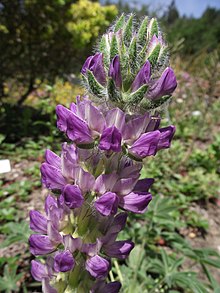Lupinus densiflorus
| Lupinus microcarpus | |
|---|---|
 |
|
| Lupinus microcarpus var. microcarpus | |
| Scientific classification | |
| Kingdom: | Plantae |
| (unranked): | Angiosperms |
| (unranked): | Eudicots |
| (unranked): | Rosids |
| Order: | Fabales |
| Family: | Fabaceae |
| Genus: | Lupinus |
| Species: | L. microcarpus |
| Binomial name | |
|
Lupinus microcarpus Sims |
|
Lupinus microcarpus, the wide-bannered lupine or chick lupine, is a species of lupine native to western North America from southwestern British Columbia south through Oregon and California, including the Mojave Desert, and into Baja California. There is also a disjunct population in South America, with locations in central Chile and western Argentina.
Lupinus microcarpus is an annual plant growing to 80-centimetre (31 in) tall. The leaves are palmately compound with 5-11 leaflets 1-centimetre (0.39 in)–5-centimetre (2.0 in) long and up to 1-centimetre (0.39 in) broad.
The flowers are generally pink to purple in color, but can also be between white and yellow; they are produced in open whorls on an erect spike.
Lupinus microcarpus grows from sea level in the north of its range, up to 1,600-metre (5,200 ft) high in Southern California.
There are three named botanical varieties:
Chilean scientists (Universidad de Santiago de Chile) studying phytoremediation waste management in the city of Antofagasta, discovered that plants are capable of absorbing arsenic from the soil.
...
Wikipedia
